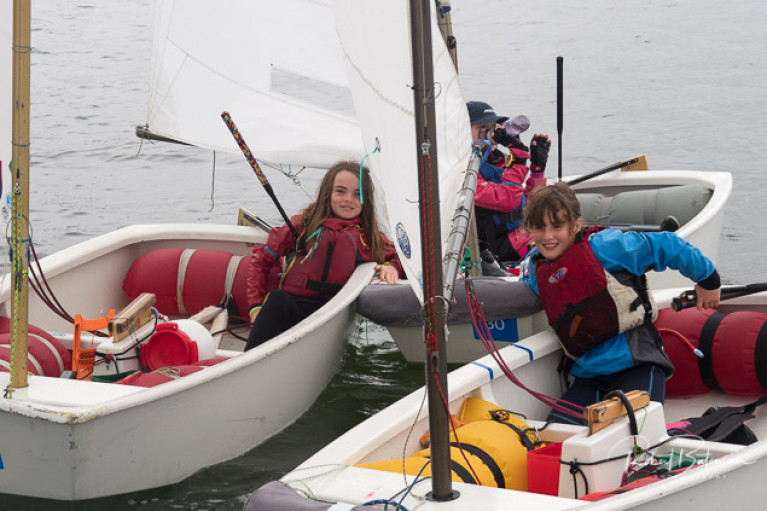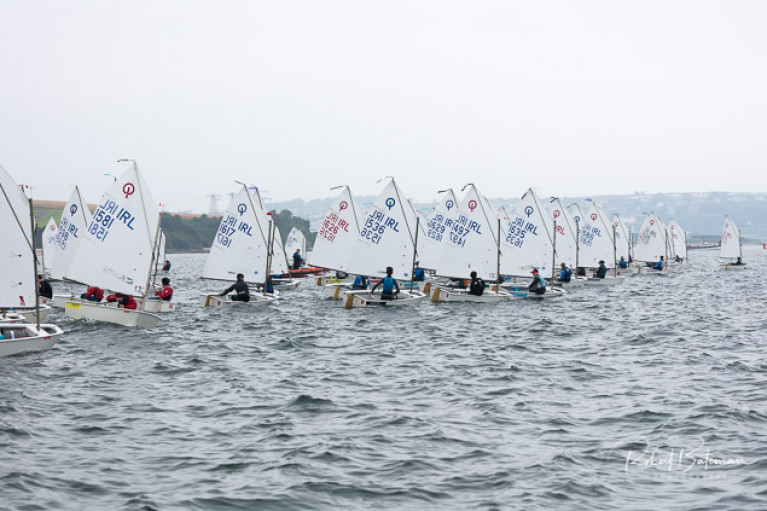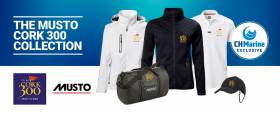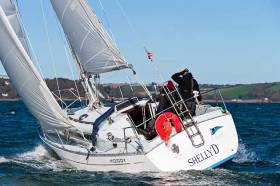Displaying items by tag: Royal Cork
Kinsale's O'Suilleabhain Takes ILCA 7 Win at Royal Cork Dinghy Frostbites
The final day of the Carrigaline Court Frostbite league at Royal Cork Yacht Club looked like it could live up to its name on Saturday, Nov 25th, as a large anticyclone settled in over the south coast, leaving clear skies and very little wind on the preceding days.
With not a breath of wind at the club at 11 am, the AP was raised while the optimism of the race officer, Ciaran McSweeney, was tested. He headed out to the bank with his mark-laying team, including his son David McSweeney and Sarah Kiely and found a steady breeze building.
Although the wind stayed mostly above eight knots and built to 13 at one stage, it still showed incredible fickleness with 120-degree wind shifts from 180 to 270 and finally back to 160 at the end of the day. At one stage, he had to clear the decks and start from scratch with all the marks moving.
 420 dinghy racing at the Royal Cork Yacht Club Carrigaline Court Hotel Dinghy Frostbites
420 dinghy racing at the Royal Cork Yacht Club Carrigaline Court Hotel Dinghy Frostbites
All boats were launched around noon, and fleets of ILCAs, Toppers and 420s were set off on a shifting breeze and a flooding tide that really started to show its influence in the first race.
Micheal O'Suilleabhain managed to pull another two bullets v Jonathan O'Shaughnessy's single win on the final day to consolidate his lead at the top with illness slowing Emmet O'Sullivan's challenge to the ICLA 7s in his RS Aero (raced with the ILCA 7 fleet on PY).
 ILCA racing in Cork Harbour at the Carrigaline Court Frostbite League at Royal Cork Yacht Club
ILCA racing in Cork Harbour at the Carrigaline Court Frostbite League at Royal Cork Yacht Club
In ILCA 6, Andrew Kingston managed one bullet between two mixed races to consolidate his lead over the field, with Liam Duggan quietly slipping into second position ahead of Max Tolan. Phillip Doherty also performed well to finish fourth overall.
The O'Neill family dominated the ILCA 4 field, with Craig again pulling out three wins to finish well ahead of Shane Collins, who maintained his bulwark against the rising Andrew O'Neill in third and Julie O'Neill in fourth (and first girl). A welcome return for Sophie Crosbie in the ILCA 4, who managed a third in the final race with an extremely tight strategic downwind leg to keep the finish boat on their toes.
In the 420 fleet, Abbie Shorten, and Isha Duggan pulled out two wins to cement their first place, followed by Matt Mapplebeck and Billy Mallin.
 Topper racing in Cork Harbour at the Carrigaline Court Frostbite League at Royal Cork Yacht Club
Topper racing in Cork Harbour at the Carrigaline Court Frostbite League at Royal Cork Yacht Club
In the Topper fleet, Ellen McDonagh also finished strong with a win in the final race to maintain an unassailable lead over Gwen Barry and Ruby Foley.
All results can be found below.
On the committee boat, Ciaran McSweeney, Stephen O'Shaughnessy and sub-RO Tim McCarthy managed to fill a full twelve races for the ILCA 7s and 6s in November and racing across five fleets in a very impressive manner, with sailors rarely having more than five minutes rest between racing. At this time of year, keeping the sailors moving was a priority.
 On station - a view from the finish boat at the Carrigaline Court Frostbite league at Royal Cork Yacht Club
On station - a view from the finish boat at the Carrigaline Court Frostbite league at Royal Cork Yacht Club
Other volunteers across the series, Carla Miles (Safety lead), Ronan Duggan, Roy Sugar, Craig and Jenn O'Neill (wandering star - finish boat), Sarah Kiely, Muireann Fitzpatrick, David McSweeney, Michael Crosbie, Sophie, Angelo and Matt Hiras.
Many thanks to Maurice Collins as ever in one of his final events as rear Admiral of Dinghies and to the generous sponsorship from Carrigaline Court Hotel.
Royal Cork's 'Wildcard Racing' are Flying the Irish Flag at the J70 World Championships
Royal Cork Yacht Club's Wildcard Racing are flying the tricolour in at this year's J70 World Championships this week from October 17 to 22nd.
Wildcard is being helmed by Trinity College Dublin student Harry Twomey. At 19 years of age he is the youngest helm at the event this year.
Taking a place on the leaderboard for Wildcard Racing will not be easy as they are up against 90 international teams from 23 nations who have descended on the Principality of Monaco for this years J70 World Championships in the quest for glory.
The qualifying process has ensured the quality of the fleet and guarantees to be a week of exceptional sailing and high competition. Among the 90 crews are World Champions in this class, such as Luis Bugallo, Marshall King, Ian Wilson, Peter Duncan, Jud Smith and Paul Ward. Alongside are stars on the European scene set to put up a fight with the likes of Italian Luca Domenici, the Dane José María Torcida Seghers and British sailor Jonathan Calascione.
Every J70 World Championship is a battle of the very best to the end. This years event in Yacht Club de Monaco will be no exception with 400 experienced sailors roaming the quays. Amongst them the Irish flag will fly over Wildcard Racing and Harry Twomey, William Twomey, Richie Harrington and Cian Byrne from the Royal Cork will be hoping to repeat their form from last year when they won the Monaco the 2022 J70 Winter Series in the Corinthian division.
Royal Cork’s First Female Vice Admiral Says She’s ‘Standing on the Shoulders’ of Women Not Given Same Opportunities
The Royal Cork’s first female Vice Admiral has spoken of her pride at making history in the world’s oldest yacht club.
As previously reported on Afloat.ie, Annamarie Fegan was elected at the club’s 301st AGM in early January.
She is best known in sailing circles as co-owner of Nieulargo with husband Denis Murphy and daughters Molly and Mia.
The boat can count the Dun Laoghaire to Dingle and Fastnet 450 among its victories, and it’s one of the favourites for the Round Ireland Race in 2022.
Fegan will also co-chair Volvo Cork Week 2022 with Ross Deasy.
Speaking to EchoLive.ie, Fegan said of her pioneering new role: “I’m standing on the shoulders of lots of women who didn’t have the same opportunities. There’s a huge surge of support for me from both male and females.”
EchoLive.ie has much more on the story HERE.
5o5 Book to Be Launched at 2022 Royal Cork World Championships
The launch of the long-awaited 5o5 Book telling the story of the 5o5 and how it has come to dominate the performance dinghy scene will finally be launched at the World Championship in Cork.
2022 is already shaping up to be a great year for the 5o5 Class, for after being forced by Covid to cancel their last two World Championships, scheduled for Sweden and Bermuda, the good news is that this event will return to Cork, in Southern Ireland next August.
As Afloat reported previously, this will be the fourth time that the Royal Cork Yacht Club will have hosted this prestigious event, with 1959, 1964 and the 1982 World Championships being regarded as classics, held across a wide range of conditions.
With the Royal Cork being acknowledged as the world's oldest yacht club, it is fitting that mid-championship next year that they will be hosting the launch of the long-awaited book telling the story of the 5o5, and how it has come to dominate the performance dinghy scene.
There is a very good saying that warns readers to 'not judge a book by its cover' but this is one occasion when the cover itself will have a big part to play, as it will lead the reader into the detailed narrative set out in the book. There are lots of fantastic pictures of FiveOs out there, as the boat has always been very photogenic, but for the book cover something special will be needed.
Luckily, Christophe Favreau, the famous international marine photographer has long enjoyed a close association with the 5o5 Class, and over the years has captured the best of the action at events around the world. Now, as the book moves towards being launched, Christophe has generously donated a selection of some of his iconic photos, one of which will be selected on the book cover.
The 12 cover shots to be posted starting December 25.
More here
After Day Two Abandonment, Lasers Go Afloat for Royal Cork Laser Championships in Lighter Winds
27 knots of wind on day two of the AIB Laser Nationals at Royal Cork Yacht Club led to the abandonment of racing in all three fleets yesterday.
The combined 99-boat fleet is, however, preparing to go afloat this morning in lighter winds for day three of the Cork Harbour Championships with a scheduled launch time of 0930.
As Afloat reported previously, fleet leaders hold perfect scores after day one's four races of the championships.
The Race Committee has advised competitors it will be enforcing the 7-metre painter rule that must be carried by all competing boats.
The day three launch sequence in Crosshaven is Standards first, Radials second and 4.7s third to launch.
Last weekend's AIB Optimist National Dinghy Championships at Royal Cork Yacht Club featured a 36-boat Regatta Fleet that features an introduction to sailing and welcomes children from 8-15yrs.
The fleet is designed to give children coaching and confidence in a fun atmosphere at an IODAI event with an emphasis on training. All this was certainly evident over the four days at Royal Cork Yacht Club, the hosts for the 2020 event where the regatta fleet sailed in the sheltered waters of Cork Harbour.
In the Regatta fleet racing, the Bateman family had great success with local sailor Ethel Bateman taking first place, closely followed by her brother Olin in second. Third place went to Henrietta Leech from Lough Ree Yacht Club, in fourth place was Fionn Hayes RCYC/MBSC and Maria Butler NYC finished in fifth place.
Bob Bateman's Optimist Regatta Fleet SlideShow is Below
Royal Cork's Ben O'Shaughnessy Continues to Lead Optimist Championships on Home Waters (Slideshow Here!)
After seven races sailed in light and tricky conditions in Cork Harbour, local Optimist dinghy ace Ben O'Shaughnessy of Royal Cork Yacht Club continues to lead the AIB sponsored National Championships overall.
The 79-main boat fleet sailed again on day three of the championships on the Harbour's Curlane Bank in light winds.
The 14-year-old Crosshaven sailor is now nine points clear of nearest rival Johnny Flynn of Howth Yacht Club. Flynn has a similar cushion on his Dublin clubmate, Rocco Wright, in third place on 29 points. Full results are here
See Bob Bateman's photo slideshow below
Get The Musto Cork 300 Collection Only At CH Marine
Musto is the official clothing partner to Cork 300 — the Royal Cork Yacht Club's 300th anniversary celebrations in 2020 — and CH Marine is proud to be the exclusive supplier of the Musto Cork 300 Collection.
This select range of Musto garments and luggage, embroidered with Cork 300 branding, makes for wonderful gift ideas for this Christmas — along with CH Marine’s wide range of lifestyle and casual wear, nautical equipment and so much more.
CH Marine ships worldwide, with free delivery within the island of Ireland for orders over €50 — and all purchases made by 24 December stand a chance to win a huge €1,000 Musto voucher.
I attended the SCORA annual meeting this week. I was seeking a particular answer about boats. The attendance at the meeting was the biggest in some years, a tribute to the work which the South Coast Offshore Racing Association’s Commodore has put into the organisation.
Who says women can’t lead the men?
Johanna Murphy from Great Island Sailing Club has been doing a pretty good job at SCORA, where the main decision at the agm was that the combined Cork Harbour Clubs League will run next year in May/June and September, but not in July. The turn-out on Saturdays in July this Summer was regarded as not big enough in comparison to the Friday nights, to continue with it. August is a holiday month when many boats head west. On Friday nights in July the clubs can resort to their own events.
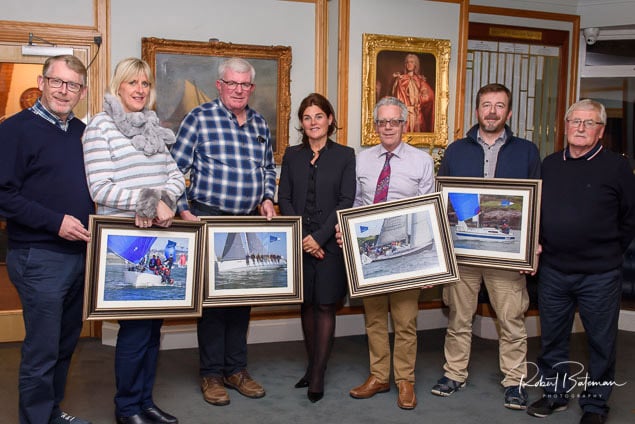 SCORA prizewinners with Commodore Johanna Murphy (centre) Photo: Bob Bateman
SCORA prizewinners with Commodore Johanna Murphy (centre) Photo: Bob Bateman
Handicapping was a usual topic, ECHO handicaps are open to question. Not everyone is pleased with the current ones. The restoration of a handicapping committee is on the cards, The Queenstown Race from Dun Laoghaire for the RCYC Tricentenary was mentioned with detailed arrangements and the South Coast Racing Calendar to be drawn up in a few weeks.
So, with the meeting over I go to my purpose for being there – to ask the stalwart of the Association, its Secretary and Treasurer for many years, Michael Murphy, what is the attraction of a 40-year-old boat?
A few weeks ago at the RCYC there was a bit of celebration about his ownership of Shelly D for that length of time but no one got him to explain why he’s been a one-boat-owner for so long. I was curious, so I asked him and his answers are fascinating, worth listening to, because what he says and how he puts it, could not be conveyed adequately, solely by the written word.
So listen to him on the Podcast below.
Countdown to Baltimore Optimist Spring Training Week
#Optimist - Baltimore Sailing Club have started preparations for the annual invasion of Irish Optimist sailors for the week from next Sunday 17 February.
The International Optimist Dinghy Association of Ireland’s (IODAI) team of coaches are making plans for training both on and off the water.
Participating sailors are reminded to check and label all their equipment before packing for the week, especially if it has been put away all winter.
“We are looking forward to a great week of fun, action and friendships both on and off the water,” the IODAI said.
Meanwhile, registrations are now open for the 2019 Optimist Trials which will take place as part of the Irish Sailing Youth Nationals at the Royal Cork from 25-28 April.
Entry is by invitation only based on 2018 season results. Entries made before 10pm on Thursday 28 March will avail of the early bird rate of €120 (entry thereafter is €200) with the final date for entries no later than 10pm on Thursday 11 April.


























